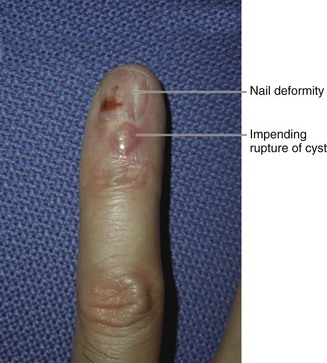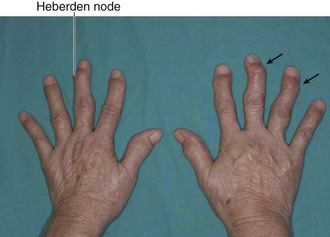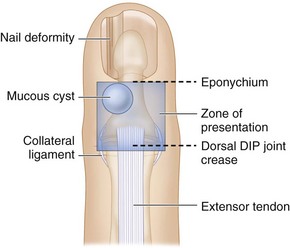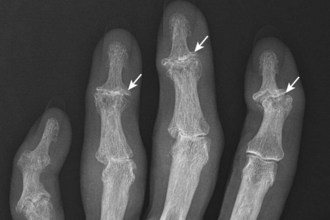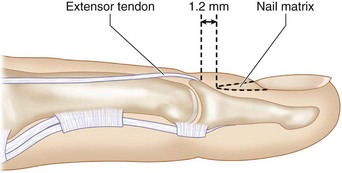Procedure 91 Treatment of Mucous Cysts of the Distal Interphalangeal Joint
Indications
 Patients should be advised that cyst excision might not provide complete pain relief in the context of an underlying arthritic joint because pain can be due to either the cyst or the underlying arthritic joint. The only treatment that can ensure a cyst will not recur is distal interphalangeal (DIP) joint arthrodesis.
Patients should be advised that cyst excision might not provide complete pain relief in the context of an underlying arthritic joint because pain can be due to either the cyst or the underlying arthritic joint. The only treatment that can ensure a cyst will not recur is distal interphalangeal (DIP) joint arthrodesis.
Examination/Imaging
Clinical Examination
 A mucous cyst is a degenerative cyst of the DIP joint arising as a result of osteoarthritis. It usually occurs between the fifth and seventh decades of life, and patients have DIP joint osteoarthritis including Heberden nodes (Fig. 91-2).
A mucous cyst is a degenerative cyst of the DIP joint arising as a result of osteoarthritis. It usually occurs between the fifth and seventh decades of life, and patients have DIP joint osteoarthritis including Heberden nodes (Fig. 91-2).
 The cyst may present on the dorsum at the level of the DIP joint on either side between the extensor tendon and the collateral ligament or under the eponychium to cause longitudinal grooving of the nail plate (Fig. 91-3).
The cyst may present on the dorsum at the level of the DIP joint on either side between the extensor tendon and the collateral ligament or under the eponychium to cause longitudinal grooving of the nail plate (Fig. 91-3).
Surgical Anatomy
 The mucous cyst originates from the DIP joint in relation to one of the osteophytes, and the stalk of the cyst passes between the collateral ligament and the extensor insertion to present on the dorsum of the DIP joint. Occasionally, the stalk can connect with another mucous cyst on the opposite side of the DIP joint. This cyst may not be clinically obvious (occult cyst), and the entire DIP joint should be examined during surgery.
The mucous cyst originates from the DIP joint in relation to one of the osteophytes, and the stalk of the cyst passes between the collateral ligament and the extensor insertion to present on the dorsum of the DIP joint. Occasionally, the stalk can connect with another mucous cyst on the opposite side of the DIP joint. This cyst may not be clinically obvious (occult cyst), and the entire DIP joint should be examined during surgery.
 The terminal extensor insertion is about 1.2 mm from the proximal edge of the nail matrix (Fig. 91-5).
The terminal extensor insertion is about 1.2 mm from the proximal edge of the nail matrix (Fig. 91-5).
Stay updated, free articles. Join our Telegram channel

Full access? Get Clinical Tree




